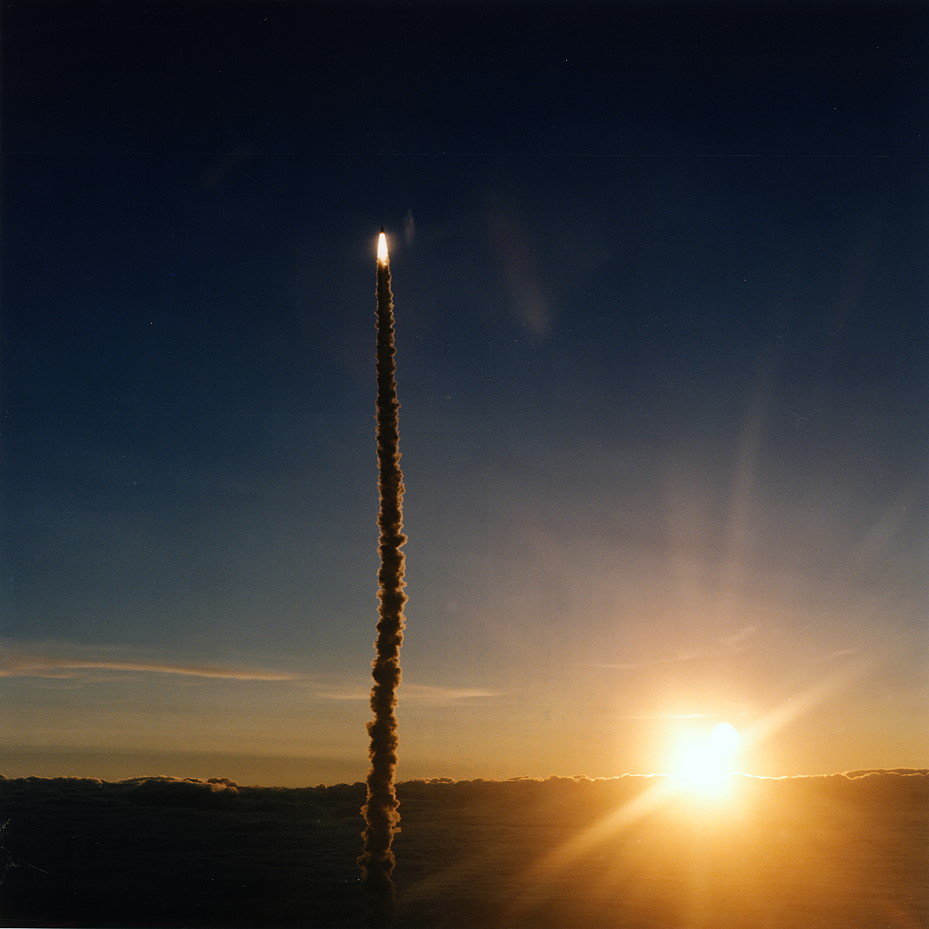
Early on 20 May 1996, astronaut Mario Runco Jr. grappled SPARTAN-207—a small, free-flying spacecraft, equipped with a very unique payload—and unberthed it from Endeavour’s payload bay with the shuttle’s Canadian-built Remote Manipulator System (RMS) mechanical arm. With his five crewmates, he had launched into orbit barely 24 hours earlier, to kick off the 10-day STS-77 mission. SPARTAN, an acronym for “Shuttle Pointed Autonomous Research Tool for Astronomy,” was a frequent flyer aboard the shuttle, having supported numerous astronomical and solar physics experiments, as well as space technology investigations. On STS-77, however, it undertook its most ambitious mission to date. Runco released the satellite, precisely on time at 7:29 a.m. EDT, after which STS-77 Commander John Casper maneuvered the shuttle to a distance of about 820 feet (250 meters). He held the position of his ship for about an hour, then conducted a partial fly-around, to a point directly “above” the satellite, and began an 80-minute-long station-keeping exercise to observe a remarkable experiment—an experiment which carried potentially enormous benefits for a multitude of applications, from space radar to mobile communications, from astronomy to Earth observations, and from environmental research to analyses of soil moisture and ocean salinity. Eighteen years ago this week, STS-77 put the shuttle’s many capabilities to work and served as a pathfinder for future International Space Station (ISS) research.
Two hours after Runco released SPARTAN-207, the Inflatable Antenna Experiment (IAE) got underway. Designed and built by L’Garde, Inc., a small aerospace company, based in Tustin, Calif., together with NASA’s Jet Propulsion Laboratory of Pasadena, Calif., it sought to inflate a 46-foot-wide (14-meter) Mylar antenna dish, at the apex of three deployable struts, as part of an investigation into how large, expandable structures behaved and functioned in the microgravity environment. Since 1971, L’Garde had pioneered the construction of thin-skinned, multi-task balloons and its products included a decoy missile for the Department of Defense. It had long been recognized that the mass and stowed volume of inflatable space components was significantly less than an equivalent solid structure and that this carried the potential to reduce by 10-100 times the cost of future missions. In 1988, L’Garde began working on the IAE, and, according to the company’s founder and vice president, Alan Hirasuna, the $14 million cost of this inflatable antenna was a mere fraction of the $200 million to build a similar-sized antenna with more conventional materials. Moreover, its compactness and 130-pound (60-kg) weight meant that it could be carried aboard much smaller launch vehicles.
At 9:38 a.m. EDT, as six pairs of astronaut eyes and a battery of still, video, and motion-picture camera equipment aboard Endeavour looked on, SPARTAN-207 commanded the deployment of IAE’s supporting tripod, each of whose neoprene-coated Kevlar limbs unfolded to a length of 92 feet (28 meters). At their apex, a canister of pressurised nitrogen gas inflated the antenna, in just five minutes, to its full 46 feet (14 meters) diameter. With a silver reflective surface on its topside and a clear underside, the IAE was then observed and photographed over the following 90 minutes by the STS-77 crew and illuminated by an array of lights aboard SPARTAN-207 to precisely measure its smoothness. The antenna was then jettisoned, steadily moving “below” and “ahead” of the satellite, as Casper executed a Reaction Control System (RCS) thruster firing to maneuver Endeavour “above” and “behind” it. They would maintain a distance of 55-70 miles (90-110 km) from SPARTAN-207 for the next two days.
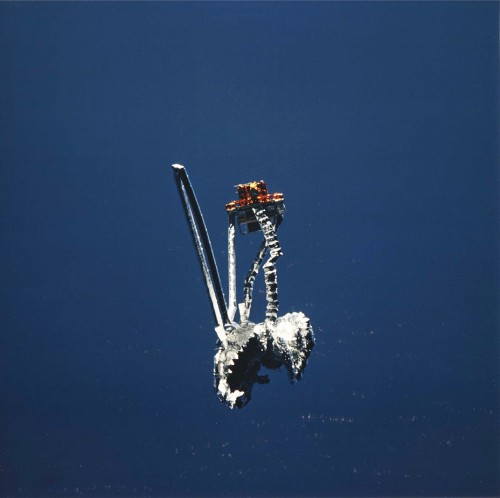
It was a great success for the entire crew, and not least for Casper and Runco, who were making their second shuttle mission together. John Howard Casper, an Air Force colonel, was making his fourth flight overall. He was born in Greenville, S.C., on 9 July 1943 and after high school entered the Air Force Academy to study engineering science. He earned his degree in 1966 and completed a master’s qualification in astronautics from Purdue University, early the following year. Following initial flight instruction, Casper received his wings at Reese Air Force Base in Texas, trained on the F-100 Super Sabre, and was despatched to Vietnam, where he flew more than 200 combat missions. Upon his return to the United States, he continued to fly the F-100, as well as the F-4 Phantom, and was assigned as an exchange pilot to a tactical fighter wing at RAF Lakenheath base in England. Casper then attended test pilot school at Edwards Air Force Base, graduated in 1974, and headed the F-4 Test Team, performing weapons separation and avionics testing. He later worked at the Pentagon as deputy chief of the Special Projects Office, developing Air Force positions on requirements, operational concepts, policy, and force structure for tactical and strategic programmes. In February 1990, Casper flew his first mission as pilot of STS-36 and subsequently commanded STS-54 and STS-62.
Mario Runco Jr.’s quite remarkable career path had seen duty as a police state trooper, then a Navy oceanographer and meteorologist and ultimately an astronaut. Born in the Bronx, N.Y., on 26 January 1952, of Italian-American parentage, Runco’s close resemblance to Mr. Spock (Leonard Nimoy’s character in Star Trek) proved the root of many jokes whilst at NASA. He studied Earth and planetary sciences at the City College of New York and, whilst there, played intercollegiate ice hockey. After graduation in 1974, he moved to Rutgers University for his master’s degree in atmospheric physics, again played ice hockey, and spent two years as a research hydrologist, carrying out groundwater surveys for the U.S. Geological Survey on Long Island. In 1977, Runco joined the New Jersey State Police and spent a year as a patrol trooper, then entered the Navy in June of the following year. His early military duties, not surprisingly, took full advantage of his academic and work training: He served as a research meteorologist at the Navy’s Oceanographic and Atmospheric Research Lab in Monterey, Calif., then as a meteorological officer aboard the USS Nassau from 1981-83. During this latter assignment, Runco was designated a Naval Surface Warfare Officer. He then worked as a laboratory instructor at the Naval Postgraduate School and performed hydrographic and oceanographic surveys of the Java Sea and Indian Ocean, aboard the naval survey vessel Chauvenet. Selected by NASA in June 1987, Runco’s police background led to the nickname of “Trooper.” He had flown twice aboard the shuttle, firstly as a crewman on STS-44 and more recently with Casper on STS-54.
Over the next two days, following the IAE deployment, Endeavour remained at a distance of 55-70 miles (90-110 km) from SPARTAN-207, which also carried a payload of other technology experiments, including a new solid-state recorder and advanced integrated circuits in several of its electronics boxes. By the evening of 20 May, a few hours after deployment, the discarded IAE was being tracked at a distance of more than 115 miles (185 km) “ahead” and “below” the shuttle, and although its large size and relatively low weight made it difficult for trajectory specialists to predict exactly how long it would remain in orbit, they anticipated no longer than 17-24 hours. As circumstances transpired, IAE re-entered the upper atmosphere and burned up early on the 22nd, the same day that Casper and his men re-rendezvoused with SPARTAN-207 to begin retrieval activities.
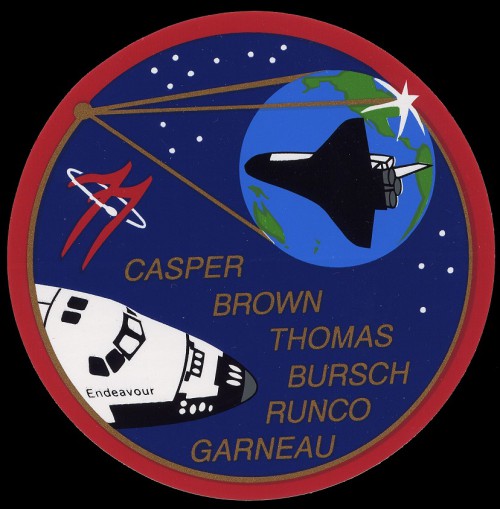
Awakened from their slumbers that morning to the sound of Fifth Dimension’s song Up, Up and Away, in honor of their completed experiment, the astronauts wasted no time preparing their equipment for the rendezvous. In a similar manner to the approach procedures followed by several earlier shuttle crews, a Terminal Initiation (TI) burn of Endeavour’s RCS thrusters kicked off the final approach and Casper guided his ship to just 35 feet (10 meters) from SPARTAN-207, whereupon astronaut Marc Garneau—who in October 1984 had become the first Canadian in space—extended the Canadian-built RMS arm and grappled the satellite at 10:53 a.m. EDT. As the satellite hung on the end of the arm, the crew performed a video and photographic survey, before it was berthed in the payload bay.
All six astronauts were intimately involved in the SPARTAN-207 rendezvous, including pilot Curtis Lee Brown Jr. and flight engineer Daniel Wheeler Bursch, both of whom were on their third shuttle missions. Brown hailed from Elizabethtown, N.C., where he was born on 11 March 1956. “My dream as a small kid was to fly,” he once said. “I fell in love with aircraft and flying movies and things about flight and built all the little airplanes that kids always did when I was growing up.” After completing high school in his hometown, Brown entered the Air Force Academy to study electrical engineering and earned his degree in 1978. He was commissioned as a second lieutenant and underwent flight instruction at Laughlin Air Force Base in Texas, later flying A-10 Thunderbolt aircraft in South Carolina. Brown’s work subsequently earned him a position as an instructor pilot on the A-10 at Davis-Monthan Air Force Base in Arizona. Graduation from the Air Force’s Fighter Weapons School at Nellis Air Force Base in Nevada in 1983 was followed by duties as an A-10 weapons and tactics instructor. He was selected for Test Pilot School at Edwards Air Force Base in June 1985, and, upon completion of this rigorous and demanding course, in mid-1986 he worked as a test pilot for the A-10 and the F-16 Falcon until his selection as an astronaut candidate in June 1987. Almost a decade later, at the time of STS-77, Brown already had two space missions under his belt as a pilot, and by the end of his NASA career in December 1999 he became the first person to have served six times as a shuttle pilot or commander. It is a distinction that, even today, after the retirement of the orbiters, he shares with only one other U.S. astronaut, Jim Wetherbee.
As Mission Specialist Two, Bursch supported Casper and Brown during ascent, re-entry, and throughout STS-77’s rendezvous activities. Earlier in his career, he had also earned the unenviable reputation of having endured two harrowing on-the-pad aborts for both his first and second space missions. Bursch was born on 25 July 1957 in Bristol, Penn., and studied physics at the Naval Academy. Upon graduation in 1979, he became a naval flight officer and trained as a bombardier/navigator in the A-6E Intruder. Overseas deployments followed to the Mediterranean aboard the USS John F. Kennedy and to the North Atlantic and Indian Oceans aboard the USS America, and upon his return to the United States he was selected for Naval Test Pilot School. Completion of the course in December 1984 was followed by A-6 test work and later duties as a flight instructor. He also served again overseas as Strike Operations Officer aboard the USS Long Beach and USS Midway and was in the process of completing his master’s degree in engineering science at the Naval Postgraduate School when selected as an astronaut in January 1990. He flew aboard STS-51 in September 1993 and STS-68 in September 1994, both of whose inaugural launch attempts were stalled in the final seconds of the countdown, and after the ignition of the shuttle’s main engines. Fortunately, Bursch’s run of cruel fortune appeared to end on his third mission and STS-77 ran like a charm.
With the successful retrieval of SPARTAN-207, the shuttle’s mission was barely a quarter complete, but its wide range of scientific and technological experiments were well underway. Flying for the fourth time as a research facility on STS-77, the commercial Spacehab was not dissimilar in appearance to the European Space Agency’s (ESA) Spacelab module, but with several key differences: It was smaller, consuming just a quarter of the payload bay, and it was designed and built not by governments, but by private enterprise. It also differed from Spacelab in overall physical shape; it was cylindrical, but with a flat roof. When the module rose from Earth for the first time aboard STS-57 in June 1993, it marked the culmination and realisation of a decade-long dream for aerospace engineer Bob Citron, who founded the Spacehab company in 1983 and incorporated it the following year.
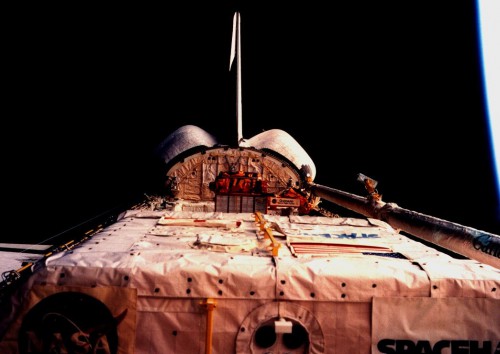
“People often ask me why I started Spacehab,” Citron recalled on the website www.astrotech.com, “and my response usually goes something like this: It took a small group of wide-eyed dreamers and determined space enthusiasts who believed we could pull it off. We didn’t have a clue about the enormous problems we would encounter and the nearly insurmountable technical, financial and institutional roadblocks that would stand in our way. Nobody had done anything like this before.” The primary goal of Citron, who died from prostate cancer in January 2012, was to create the world’s first privately funded company to support human space missions, using the cavernous payload bay of the shuttle as a carrier of commercial pressurised research modules.
The need for such provision was self-evident. In the shuttle’s pre-Challenger heyday, many missions were planned each year and a primary thrust of the Reagan Administration’s 1983 space policy was for the commercial exploitation of the microgravity environment. Already, middeck lockers were being used to carry out experiments in crystal growth and pharmaceutical development, but the limited volume meant that their commercial viability was restricted. The Spacehab module, accessed, like Spacelab, by a tunnel adapter connected to the middeck airlock hatch, measured 9.2 feet (2.8 meters) long, 11.2 feet (3.4 meters) high, and 13.4 feet (4.1 meters) across the width of the payload bay and could increase the shuttle’s pressurized research volume by almost 1,100 cubic feet (31 cubic meters), effectively quadrupling the available working and storage space. The module, which weighed approximately 9,480 pounds (4,300 kg) and could house a total payload of more than 2,870 pounds (1,300 kg), provided environmental provisions, electrical power, temperature control, and experiment command and data functions. It could carry a maximum of 61 middeck-sized lockers and up to two large racks, in either “single” or “double” configurations.
After incorporating Spacehab in 1984, Citron admitted that the company was “on the verge of failure on a number of occasions during its first years,” until he brought in critical professional management personnel and “things started to happen” through negotiations with NASA, the Italian Alenia Spazio and German MBB-Erno organisations, and Martin Marietta and McDonnell Douglas. By the end of 1985, only weeks before the Challenger tragedy, Spacehab was tentatively scheduled for its first flight in 1987, and a lease of $5 million per mission was quoted by Flight International. Early plans called for the assembly of three modules, but center-of-gravity issues gave NASA cause for concern and threatened to affect the placement of other cargoes in the payload bay.
Ultimately, McDonnell Douglas was selected as the lead contractor and a decision was made to build two flight modules and an engineering test model. Other worries lingered, but in late 1986 Spacehab signed a Space System Development Agreement, in which NASA agreed to fly five inaugural missions. By October 1987, 42 firm requests had been received, with lockers priced at $300,000 for non-government users and $100,000 for government agencies and contractors. The concept was now growing from initial designs into reality. In September 1989, Patent No. 4,867,395 for a “Flat End-Cap Module for Space Transportation System” was awarded to Spacehab, Inc., by the U.S. Patent Office.
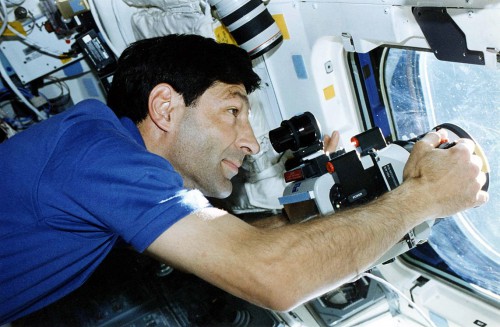
Hopes to fly the modules on very early post-Challenger missions received a rude awakening, however, and it was expected to be at least three years after the resumption of shuttle operations before a first flight could be realistically expected. According to NASA’s April 1988 schedule, Spacehab-1 was listed as a primary payload on STS-51 in June 1991, co-manifested with the retrieval of Europe’s EURECA free-flyer and the deployment of Italy’s LAGEOS-II satellite. This schedule slipped and, at length, the first module was not unveiled until early 1992 at the custom-built Spacehab Payload Processing Facility (SPPF) at the Kennedy Space Center (KSC) in Florida. By this time, under the Commercial Middeck Augmentation Module procurement, initiated in February 1990 and formally signed the following December, NASA had agreed to lease a total of 200 Spacehab lockers at a cost of $184.2 million. Over the coming years, the SPPF would host more than a hundred astronauts and cosmonauts, enabling them to train on real experiment hardware.
However, all was not smooth sailing for Spacehab, which supported three dedicated science missions between June 1993 and February 1995 and was embarking on its fourth “stand-alone” flight on STS-77. In the aftermath of the first flight, however, few contracts outside NASA materialized for the laboratory, in spite of aggressive efforts to market its capabilities. This was due to a number of factors, chiefly high Spacehab locker prices in the region of $925,000 and anticipated commercial prospects failing to materialize. “No commercial companies are ready yet to make an independent commitment to research,” said Rebecca Gray, Spacehab’s manager of government and public relations, in a Flight International interview in late 1995, despite the company having delivered its services on time and on budget.
NASA’s contract was renegotiated to cover four missions, of which STS-77—whose module, though full, was dominated almost exclusively by NASA-funded experiments—was to be the last. “If NASA requires more flights of this nature,” Flight International continued, “it is likely only to be at a rate of about one flight a year and another contract will have to be negotiated.” The company had already signed a $54 million lease contract with NASA to utilise its modules for logistics, rather than experiments, on several missions to Russia’s Mir space station in 1996-98. It also invested $15 million of its own capital to develop a “double” logistics module to be used “as a laboratory and a cargo carrier,” with the capacity to transport up to 6,000 pounds (2,720 kg) of payloads to Mir, as well as soft-stowage canvas bags for supplies. However, in the coming years, the option for more “stand-alone” research missions would be renegotiated and two would be flown, including STS-107, the final voyage of Columbia.
More than 90 percent of the Spacehab-4 payloads were directly sponsored by NASA’s Office of Space Access and Technology (OSAT), through its Commercial Space Centers and their industrial partners, as well as by several of the agency’s field centers. Right from the outset, STS-77 was dedicated to opening the commercial frontier of space, with the Spacehab module hosting almost 3,000 pounds (1,400 kg) of equipment in 28 lockers, four soft stowage bags, and a pair of single racks to support around a dozen investigations in the fields of biotechnology, electronic materials, polymers, and agriculture. These included the Advanced Separation Process for Organic Materials (ADSEP) to demonstrate separation and purification technologies for potential medical and pharmaceutical applications, the Commercial Generic Bioprocessing Apparatus (CGBA), and Plant Generic Bioprocessing Apparatus (PGBA) to investigate the influence of microgravity on molecular, cellular, tissue, and small animal and plant systems, as well as studying compounds which might someday prove beneficial as chemotherapy and anti-malaria agents and the Fluids Generic Bioprocessing Apparatus (FGBA) to explore the management of liquids in space.
The latter received corporate sponsorship from the Coca-Cola Company, which flew both Coke and Diet Coke aboard STS-77. The experiment, noted NASA, “will provide a testbed to determine if carbonated beverages can be produced from separately stored carbon dioxide, water and flavoured syrups and determine if the resulting fluids can be made available for consumption without bubble nucleation and resulting foam formation.” If so, it was hoped that such experiments might lead to a better understanding of altered tastes in target populations, such as the elderly, and how future drinks could be tailored to increase hydration. International co-operation on STS-77 was underpinned by the presence of the Commercial Float Zone Furnace (CFZF), a joint effort between the respective space agencies of the United States, Canada, and Germany to produce large, ultra-pure compound semiconductor and mixed-oxide crystals of gallium arsenide and gallium antimonide for electronic devices and infrared detectors. Another payload, the Space Experiment Facility (SEF), used a furnace to produce through vapour-diffusion a series of crystals of mercurous chloride, which is considered a valuable electro-optical material of commercial interest, and to bond powdered metals through the liquid-phase sintering process, as part of efforts to design new composites for the machine tool industry.
STS-77 was shaping up to be not only an ambitious mission in space science and technology, but as an important demonstrator of the shuttle’s myriad capabilities as a research platform, as a satellite deployment and retrieval facility, and as full-up precursor for the kind of work which would someday become “routine” aboard the International Space Station (ISS).
The second part of this article will appear tomorrow.
Want to keep up-to-date with all things space? Be sure to “Like” AmericaSpace on Facebook and follow us on Twitter: @AmericaSpace



